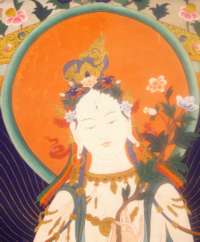In the mandala of the Five Buddhas the Buddha Amitābha is red and sits in the western quarter. He is associated with the element fire, and his wisdom is the discriminating wisdom - it sees things in their individuality, sees the detail of the world, and regards individual beings. And he is also associated with the tantric rite of fascination, the Red Rite. The 'tantric rites' are a set of magical practices of which there are several different sets. The one I know includes - purification, abundance, fascination, subduing, accomplishing; which are in turn associated with white, yellow, red, blue/black, and green; and with Vairocana, Ratnasambhava, Amitābha, Akṣobhya, and Amoghasiddhi - the Buddhas of the mandala.
These magic rites are not incidental to tantric Buddhism. Many people will try to say that they are added on, or secondary, but they feature frequently and prominently in tantric texts, and they are used in practice (according to Stephen Beyer who wrote the Cult of Tara). So how are we to understand the presence of what Snellgrove calls "vulgar magic" in Buddhism. In the Pali canon it is quite clear that the early Buddhists were very much against this kind of magic. There are several passages where the Buddha decries the practice of magic - especially that associated with the Atharvaveda. There is a clear distinction from the siddhis, the super-normal or psychic powers such as clear-audience, which are the results of profound meditation. These are relegated into second place compare to the great siddhi of Awakening, but the practice of magical spells is considered to be wicked. We must hold this along side the fact that in the Pali Canon there are magical texts, parittas, which when chanted are said to protect, for instance, from snake bite, or from attack by yakkhas and other demons. Angulimala performs a magical spell known as a "truth-act" or saccakiriya and relieves the suffering of a woman in labour in his eponymous sutta. Similarly the Mahayana sutras frequently assert that merely chanting the sutra is enough to protect the devotee from all kinds of harm. So we can't really pretend that magic is foreign to Buddhism, we just don't quite know where or how it fits.
Another feature of tantric magic which may be difficult to understand is the presence of what can only be called Hindu elements. For instance in the Tara Tantra, which is the ultimate source of the many Tara practices in Tibet, there is a lot of use of cow shit. This practice can only have come relatively late as the cow was not sacred in the Buddha's time, nor was it in the Vedas. So whence comes this foreign matter in our 'pure' Buddhism? As I've mentioned before the Indian practice was not so much to destroy heretics and competing faiths, but to assimilate them - this happened multiple times across all of the religions, and helps to account for a constant preoccupation in Buddhist scripture with distinguishing Buddhism from other faiths.
The Buddhist magical system has it's roots in the ancient Vedic religion. It is what anthropologists call "sympathetic magic", and works on the principle that the universe is divided into planes of being. The idea is that there are connections or correspondences (bandhu) between the various planes (loka or bhūmi), and it is possible to influence or control what is happening on the other planes by making changes in one of the other planes. In the Vedic practices one made ritual actions which were intended to control the gods, or to make changes in the physical world. This has many similarities to European style magic. Even in early Buddhism there is a clear association between the jhanas (Sanskrit dhyāna) and the devalokas, or god realms.
The Vedic religion gets a bad press from Buddhists, but there are aspects of it which are quite beautiful, and also shed light on Buddhist practice. The deva Agni was god of fire, the sun, the heat of digestion, of ritual, and of inspiration. As such he is a kind of counter-part to Amitābha. His name is cognate with the English word "ignite" and it was his role to transform the offerings made during rituals, and to transport them to the gods. But he was also bound to convey the blessing of the god back to the one who made the sacrifice - it was always a two way deal. Agni, then, operated in the liminal space between realms. He was, like the Greek Hermes and the angels of Abrahamic religions, a messenger between worlds or planes of existence. This explains his role in inspiration where we draw on our own depths, or perhaps make contact with the divine. As fire he transformed the physical offering into the ætheric substance which could be presented to the gods. The rite of fascination also operates in a liminal space - the space between individuals. It seeks to reduce that space, or to remove it all together, to draw beings together, so in a sense this is not just Amitābha magic, it is Agni magic!
The vulgar application of the Red Rite is as love magic. One uses the rite to obtain the love of the one desired. But coercing love does seem unethical - to say the least. So we come back to the issue of what is vulgar magic doing in Buddhism? My take on this, which is not necessarily traditional, is that the love magic is actually exoteric. The esoteric magic works within. I can't say whether magic works in the exoteric sense, I can say without any hesitation that the inner magic does work! I want to show how esoteric tantric magic might work by using two examples which are not particularly tantric:
In the seven factors of enlightenment the second factor is dhamma-vicaya - investigation of phenomena. In this scheme one becomes mindful, and then with mindfulness one investigates phenomena, and on the basis of that arises first energy, then rapture, tranquillity, samādhi and equanimity - and with the equanimity born of samādhi one is close to Awakening. What is required here, then, is interest. In order to spend time investigating the nature of phenomena, one must be interested, one must become fascinated with the minutiae of things. This is an application of the discriminating wisdom, and the act of doing it is a performance of the rite of fascination. In the kind of meditation where there is an object, we try to become so fascinated by the object that we cease to experience any distinction between our experience of ourselves and the object - and this closing of the gap is also the red rite.
My second example refers to a particular meditation practice: mettā bhavanā, the development of loving kindness. In the mettā bhavanā we seek to experience a sense of loving kindness for, and a solidarity with all beings. It is often taught as a beginners practice, but is actually profound in it's implications and has this esoteric significance that one is trying to at least attenuate, if not remove altogether, the sense of separate selfhood and self interest. What is happening in this meditation is that we are trying to will the well-being of others, without preference. And to do this we begin with ourselves, then focus on a friend, a neutral person, an enemy and then all of these together, and then all beings. Because we start with the particular and move towards the universal this is once again an application of the discriminating wisdom. We must experience this loving kindness in response to individual beings before we can attempt to universalise it, because love, kindness, well wishing are not abstract, but occur in relation to actual people. And the effect is to close the gap between ourselves and others - the red rite again!
By practising the Red Rite in meditation, we make changes in ourselves, and this in turn does actually result in changes in the objective phenomenal world. When we combine the practice of absorption with the investigation of phenomena, we do begin to see the impermanence and insubstantiality of the world - we do, in quite a straight forward way, begin to see things as they really are. And through the mettā bhavanā we can experience a narrowing of the gap - a person who we have found repulsive may seem neutral, or a dispute may be resolved because we are no longer actively hostile. This is the magic of Buddhist practice. It's not mumbo jumbo, it's not an illusion - things change when you take up practising Buddhism, and anyone can see for themselves.
Something I have left out is the space between the practitioner and their goal - this is another space in which the Red Rite can operate, eliminating the differences, for instance, between the yogin and their yiddam through constant repetition of the mantra. Perhaps I'll go into this in another essay.
I want to finish by restating something I've mentioned before about technology. The internet and the whole cellphone thing... they are about creating a sense of connection between human beings. Marshall Mcluhan said "the medium is the message". His idea was that the form of media tell us more about ourselves and our age than the contents of the media. When I look at the enormous energy (both figuratively and literally) going into our creation of communications networks what I see is a huge desire to commune. So, practice the red rite, the rite of fascination with life, with people, with things, and transform your experience of the world by narrowing the gap between 'you' and 'them'!



